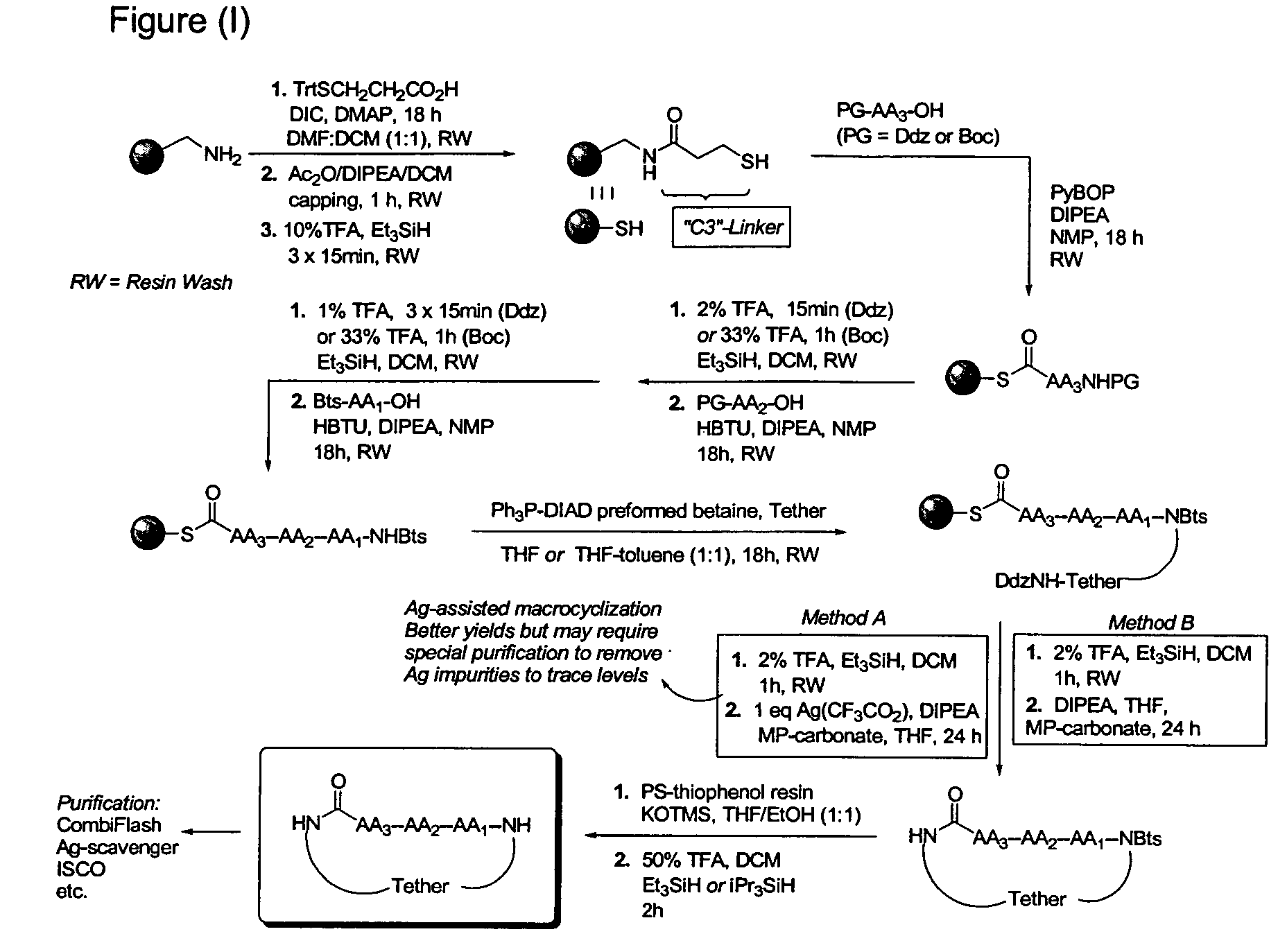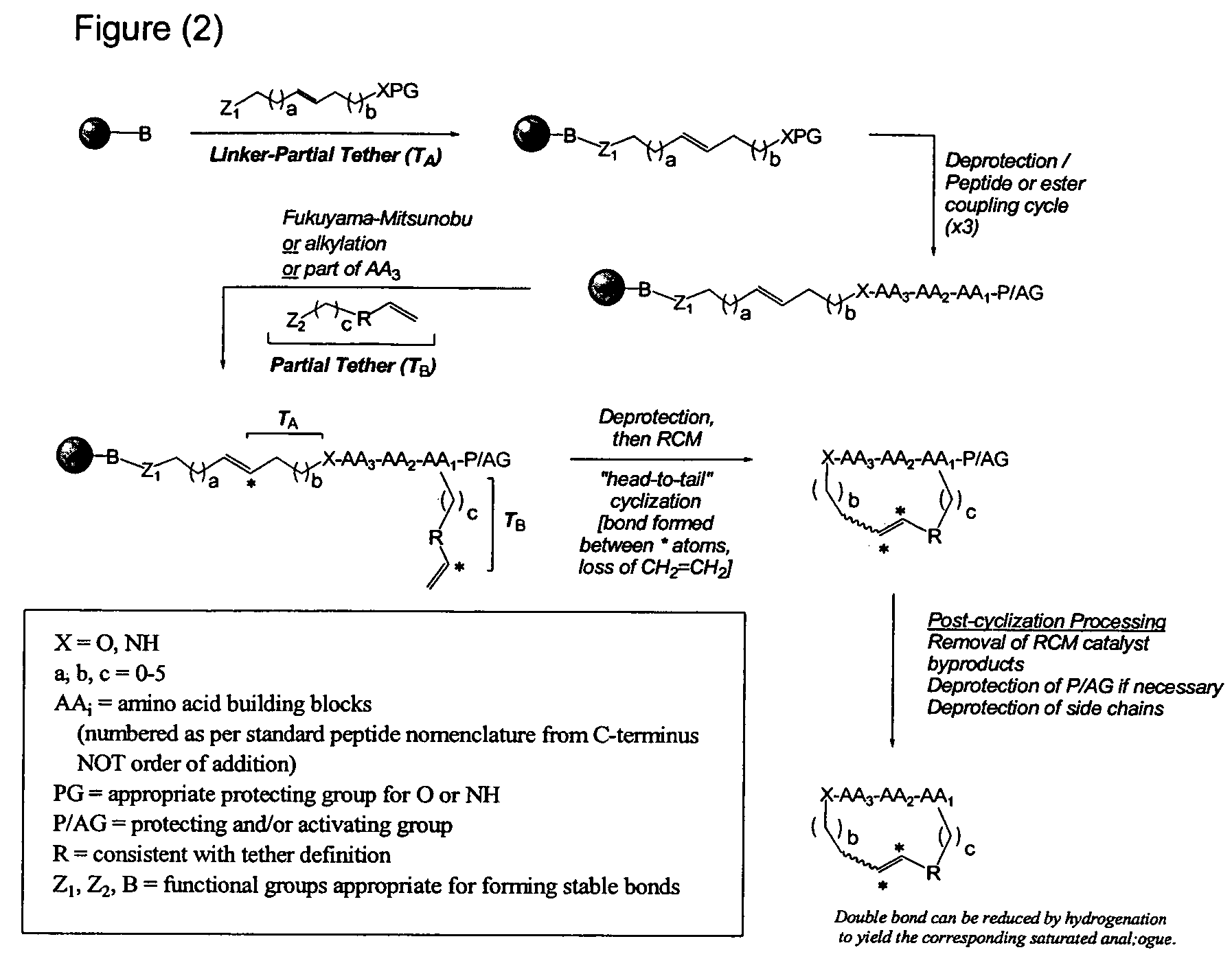Conformationally-controlled biologically active macrocyclic small molecules as motilin antagonists or ghrelin agonists
a macrocyclic, small molecule technology, applied in the field of spatially defined macrocyclic compounds, can solve the problems of restricted the wider utility of these structures, difficult to synthesize natural products, and difficult to achieve peptidic compounds
- Summary
- Abstract
- Description
- Claims
- Application Information
AI Technical Summary
Benefits of technology
Problems solved by technology
Method used
Image
Examples
examples
Synthesis Method
[0055]An assortment of synthetic strategies, involving both solution and solid phase techniques, can be used to access the macrocyclic compounds of the invention, several of which have already been disclosed in WO 01 / 25257.
[0056]An outline of a first approach to the solid phase synthesis of the compounds of the invention, using a thioester linker strategy is provided in FIG. (I). A second approach, called ring-closing metathesis (RCM), is also generally outlined in FIG. (II).
[0057]In both, the construction involves four phases: first is synthesis of the building blocks, comprising mainly recognition elements for interaction at biological targets, plus the key tether moiety, primarily for control and definition of conformation. These building blocks are assembled together, typically in a sequential fashion, in a second phase employing standard chemical transformations and those described in the Standard Procedures herein. The precursors from the assembly are then cycl...
example t13
Standard Procedure for the Synthesis of Tether T13
[0070]Protected versions of tether T13 are accessed through a route (see FIG. 4) analogous to that described below in more detail for T14, except starting from H-Ser-OEt.HCl, in an overall yield of 14-30% for the 6 step sequence.
[0071]1H NMR (CDCl3): δ 7.53 (1H, s, RR′C═CH—O), 6.42-6.58 (2H, m, Ph), 6.30-6.38 (1H, m, Ph), 5.40-5.50 (1H, m, NH), 4.57 (2H, s, CH2OH), 4.40 (2H, d, CH2NHDdz), 3.78 (6H, s, 2X(CH3OPh)), 2.23-2.00 (1H, broad, OH), 1.76 (6H, s, RR′C(CH3)2). 13C NMR (CDCl3): δ 162, 161, 155, 149, 141, 136, 103, 99, 82, 57, 56, 39, 29.
example t14
Standard Procedure for the Synthesis of Tether T14
[0072]See FIG. 5 for an outline of the synthetic scheme.
[0073]Step T14-1: A solution of 4.4 M sodium methoxide in MeOH (1.0 mL, 4.6 mmol, 0.01 eq) in DCM (300 mL) at 0° C. was diluted with MeOH (35 mL). Dichloroacetonitrile (50 g, 455 mmol, 1.0 eq) was added over 45 min and the resulting mixture stirred at 0° C. for 1 h. L-Cysteine ethyl ester hydrochloride (84.5 g, 455 mmol, 1.0 eq) was added and the reaction stirred O / N at rt. The reaction mixture was diluted with DCM and water. The separated aqueous phase was extracted with DCM (2×). The combined organic phase was dried over MgSO4, filtered and the filtrate concentrated under reduced pressure. The crude product obtained was acceptable for use in the next step without further purification.
[0074]Step T14-2: To a solution of the crude product from step T14-1 (455 mmol based on the theoretical yield) in DCM (500 mL) was added DIPEA (119 mL, 652.5 mmol, 1.5 eq). The resulting mixture w...
PUM
| Property | Measurement | Unit |
|---|---|---|
| thickness | aaaaa | aaaaa |
| pH | aaaaa | aaaaa |
| pH | aaaaa | aaaaa |
Abstract
Description
Claims
Application Information
 Login to View More
Login to View More - R&D
- Intellectual Property
- Life Sciences
- Materials
- Tech Scout
- Unparalleled Data Quality
- Higher Quality Content
- 60% Fewer Hallucinations
Browse by: Latest US Patents, China's latest patents, Technical Efficacy Thesaurus, Application Domain, Technology Topic, Popular Technical Reports.
© 2025 PatSnap. All rights reserved.Legal|Privacy policy|Modern Slavery Act Transparency Statement|Sitemap|About US| Contact US: help@patsnap.com



